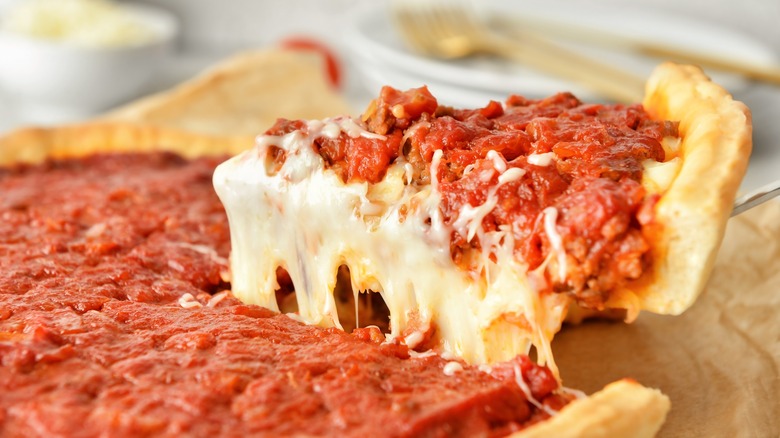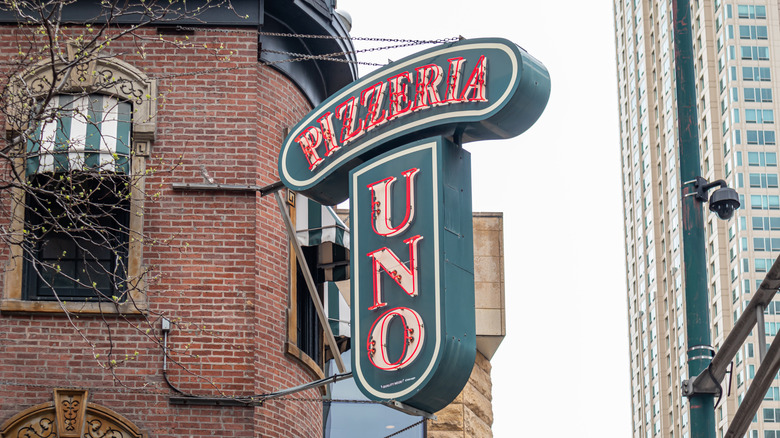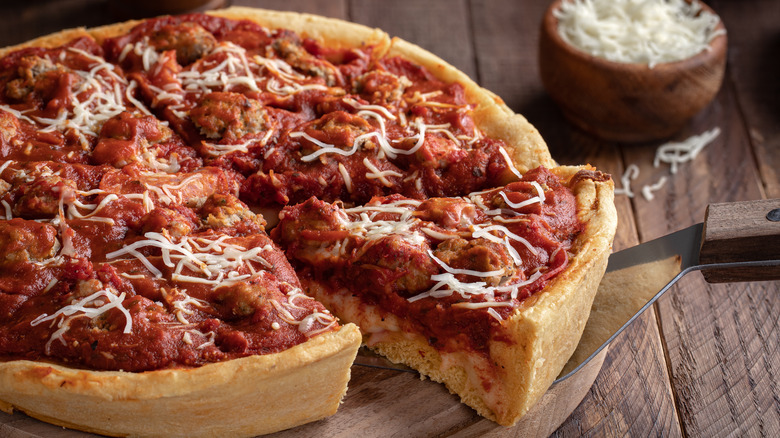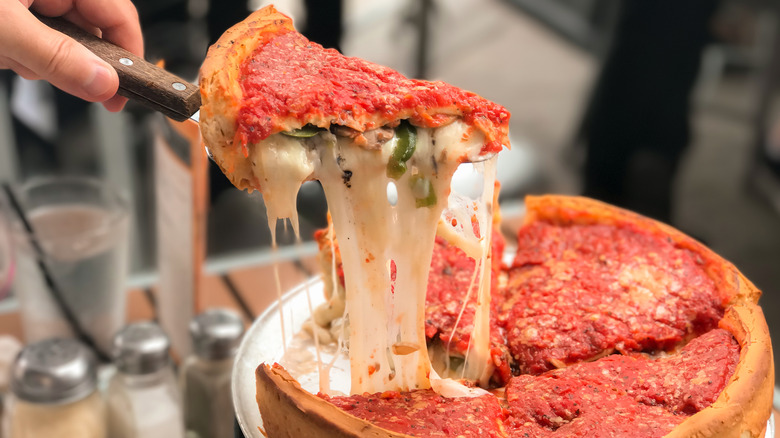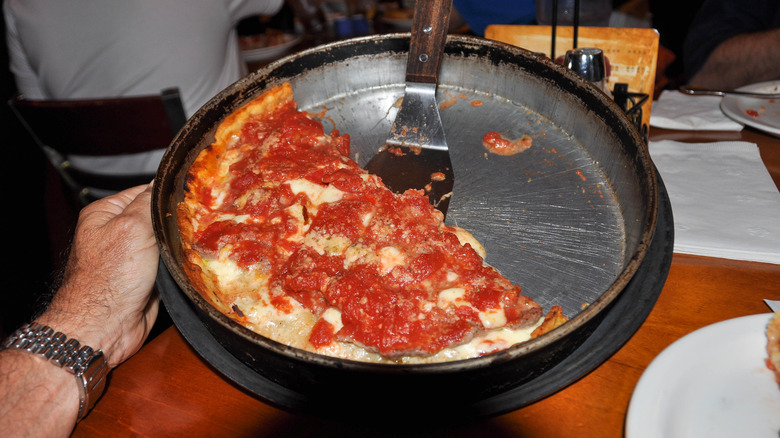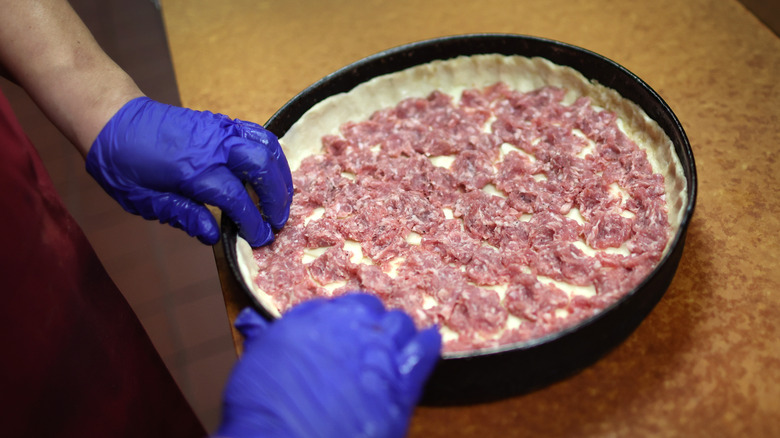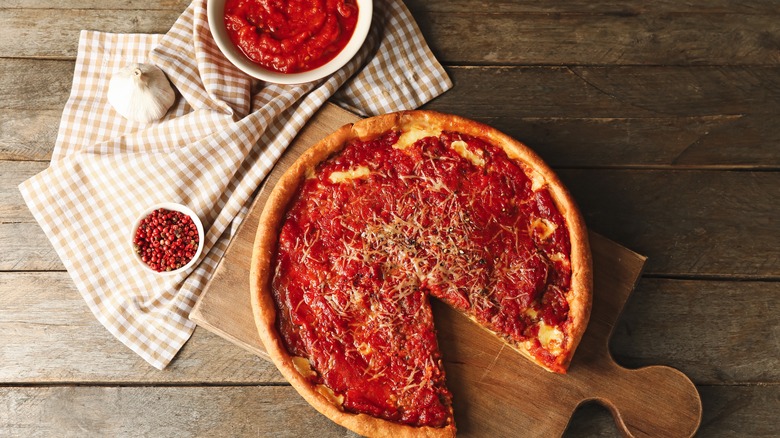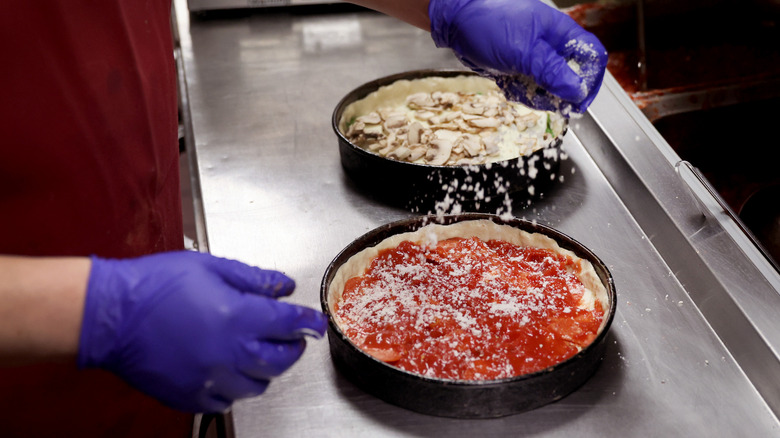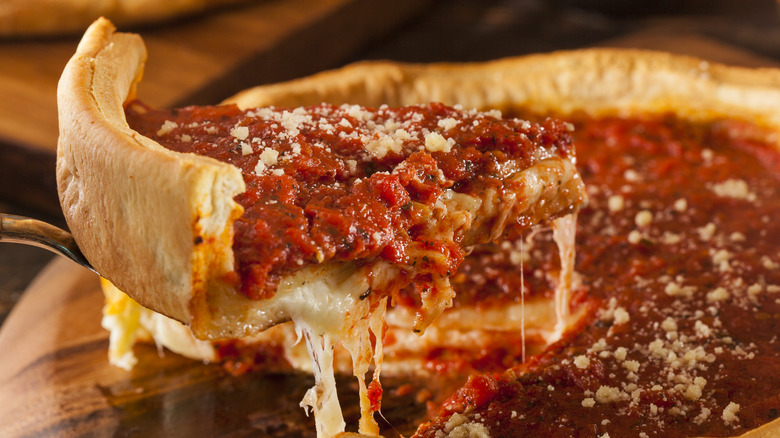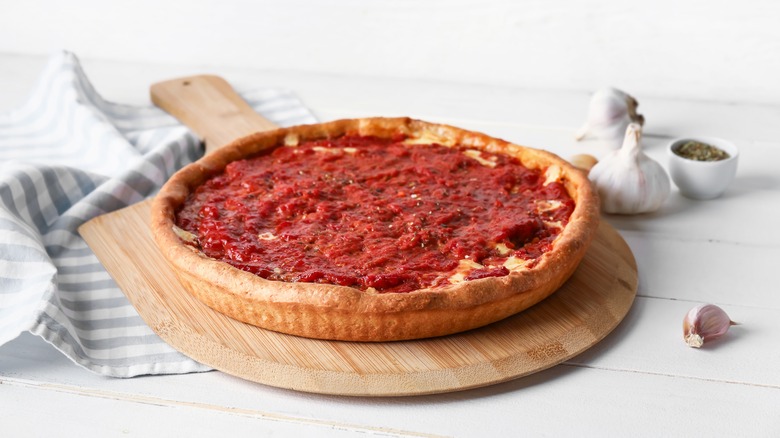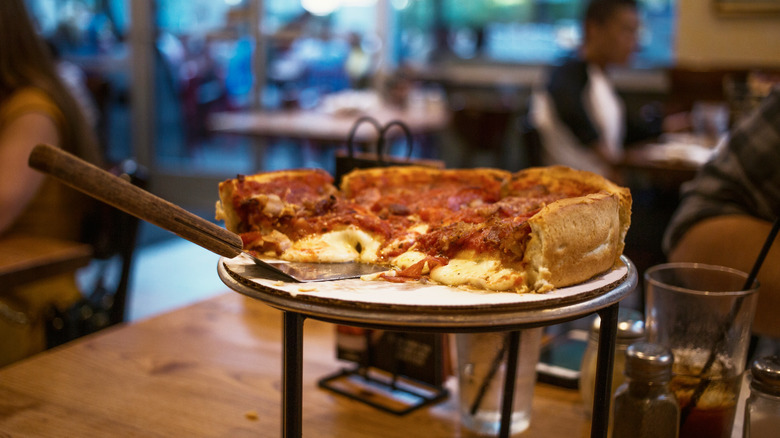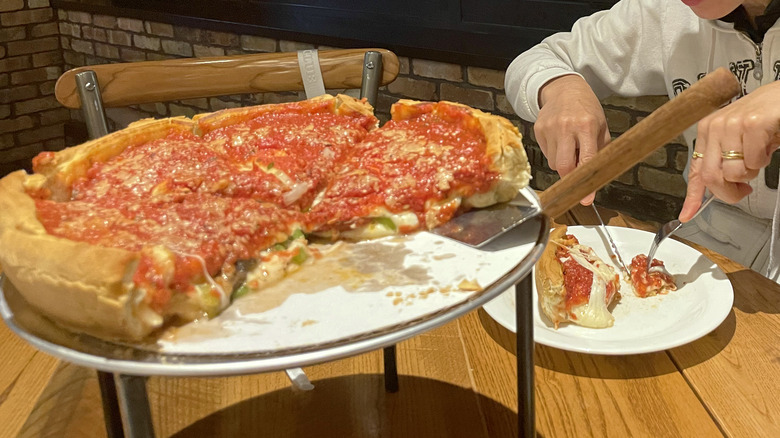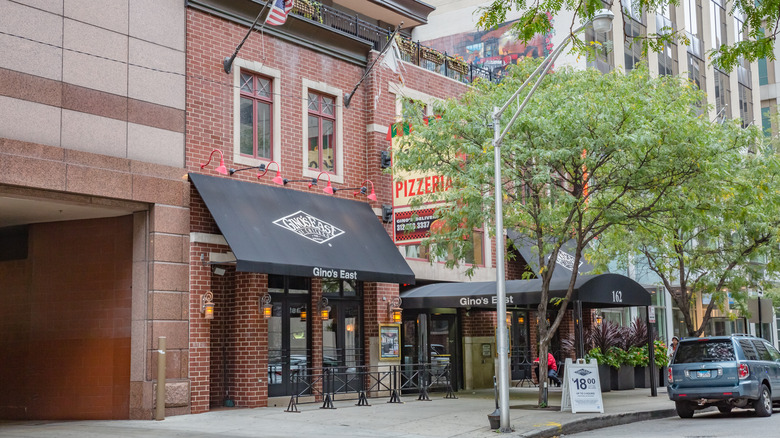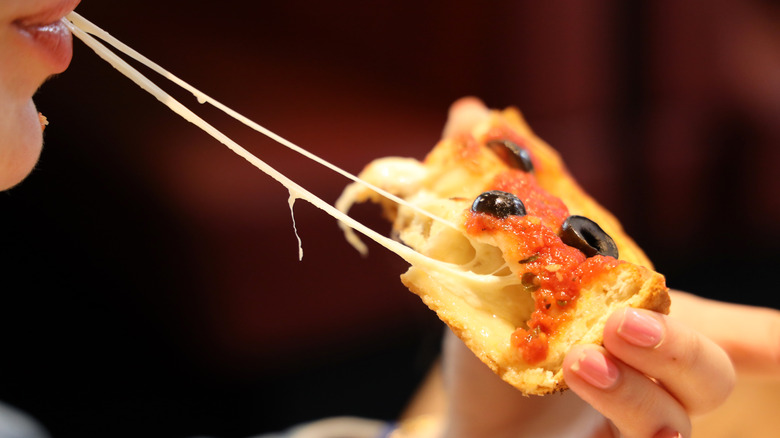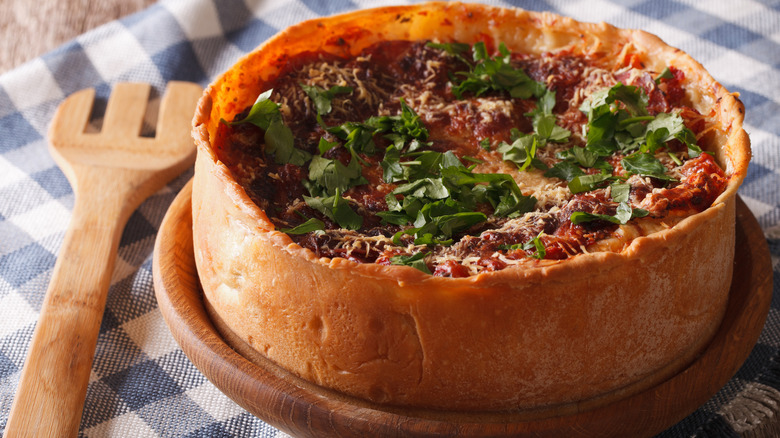A Beginner's Guide To Chicago Deep-Dish Pizza
Love it or hate it, Chicago deep-dish pizza is a style all its own. Big, brash, and bold, this Americanized version of a traditional Italian staple takes everything that makes a pizza a pizza and amplifies it, heightens it (literally), and turns it up to full volume. Its critics are numerous and vocal, dismissing it as not even pizza but something closer to a casserole or a lasagna. Still, it endures, with countless pizzerias specializing in deep-dish pies throughout Chicago and beyond.
For anyone out there who's curious about Chicago's deep-dish pizza tradition and how the style came to be, this guide is here to break it down for you. From its storied history to how it's made to where to find some of the best pies and even some tips on how to build one of these towering pizzas in the comfort of your own kitchen, we've got everything a beginner needs to know about Chicago deep-dish pizza right here.
History of Chicago's signature deep-dish style
The nineteenth century saw many immigrants from Southern Italy, particularly around Naples, crossing the Atlantic to make a home in Chicago, Illinois. These new Americans brought their culinary traditions with them, and Naples just happens to be the hub of the pizza world. Pizza in Chicago evolved from the traditional Neopolitan style, known for its tender, airy crust cooked quickly at high heat, to other styles like tavern pizza, which boasts a super thin, crispy crust. Then, in 1943, a different type of Chicago pizza was born: the deep-dish.
The first deep-dish pizzeria, eventually called Pizzeria Uno, was started by Ike Sewell and Ric Riccardo. These two are often credited with inventing the style — although the pizzeria's manager, Rudy Malnati, has a claim, and line cook Alice Mae Redmond had at least some hand in the original recipe's creation. Whoever was the first to come up with it, the pizza eventually caught on, and multiple deep-dish pizzerias opened across the city, many of them still in business today. People from around the world come to Chicago to try these hulking pies with their thick, high-walled crusts and loads of rich fillings.
What makes deep-dish different?
There are many kinds of pizza, with different types and thicknesses of crusts, unique toppings, and various cooking techniques. Many of these styles are regional, like the smoky coal-fired New Haven pizza or the thick rectangular pies from Detroit. All of these are variations of the undisputed champion of pizzas, the lauded pizza Napoletana. When you think of "pizza," the Napoletana, or Neopolitan pizza, is probably what comes to mind — a beautifully blistered crust that's thin through the center with raised edges, covered in bright crimson sauce and bubbly melted mozzarella.
The differences between classic pizza and Chicago deep-dish are obvious. First is the crust. Rather than tossed, stretched, or rolled into shape, deep-dish dough is patted along the bottom and sides of the pan in a thicker layer. It's more similar to pie crust than to typical pizza dough, with a buttery texture. Whereas classic pizzas are usually cooked in a very hot pizza oven for a few minutes, deep-dish pizza cooking time is much longer.
With a traditional pizza, you get thin layers of sauce, cheese, and other toppings, while a deep-dish has cheese on the bottom, fillings in the middle, and sauce on top. The hefty crust of a deep-dish pizza can handle a lot more ingredients than a thinner crust style, making a slice much heartier and more filling.
Are deep-dish, pan, and stuffed pizzas the same?
While they might look identical at first glance, and they are both considered Chicago specialties, deep-dish and stuffed pizza are not the same. Both have similar crusts, thick and bread-like, with high sides and often a layer of sauce on top. What makes a stuffed pizza different is that underneath the saucy top, there's another layer of dough. This extra crust makes stuffed pizza closer to a pie than any other style, with fillings baked inside of a crusty shell.
On the other hand, pan pizza has more in common with classic pizza than it does with deep-dish. As its name suggests, it's cooked in a pan with sides high enough to give it an extra thick crust. While deep-dish pizza has layers of fillings piled along the bottom and up the side walls of the crust, pan pizza's crust is evenly thick from center to edge, with more traditional thinner layers of toppings on its surface.
The pan
The pan is of utmost importance for a Chicago deep-dish pizza. It's right in the name, after all. Since the crust needs to have high sides, the pan has to be deep enough to accommodate those walls of dough. It also has to be able to withstand the searing hot temperatures of a pizza oven, so it needs to be made of a heat-tolerant metal such as steel or cast iron.
Other than that, anything goes. The diameter can vary. Some have handles, and some don't. As long as you can mold dough walls up the sides, the height can vary as well. Some pizzerias remove the pie and place it on a plate or platter before delivering it to the table, while others, like Chicago's original Pizzeria Uno, serve their deep-dish pizzas right in the pan. This helps keep the pizza warm longer, as the pan contains residual heat from the oven.
The dough
Because of the impressive architecture of a Chicago deep-dish pizza, the crust is pivotal. To have the required height, it needs to be stable enough to stand on its own. The crust also has to be thick and dense enough to hold the mountains of toppings that get piled on it without losing its integrity. For these reasons, deep-dish pizza crust must be made in a very different way than traditional pizza crust, which tends to be light and stretchy. This dough has to be robust and brawny.
Fat is the secret ingredient in deep-dish dough that makes this style possible. The inclusion of oil or butter gives it the thickness and rich texture it needs and also helps it develop a crisp exterior. The crispy edges are crucial for keeping the pizza intact, acting as a sort of shield so that the sauce and fillings don't escape.
The sauce
Like the other ingredients in a Chicago deep-dish pizza, the sauce should be hearty and robust. With a traditional pizza, the sauce must be thin to match the width of the crust and leave room for other topping layers. With Chicago deep-dish, there are no such limitations. Therefore, you'll often find deep-dish sauce to be thicker and more textured, sometimes with chopped or crushed chunks of tomato, garlic, and onion left in big pieces, giving the pizza a more intense, rustic character. It's often added to the pizza uncooked so that it gets perfectly baked with the rest of the pie and doesn't end up too dry.
You might even find multiple styles of sauce on the same pizza. There's plenty of room for more than one, so why not? A chunky tomato sauce or even a white sauce like bechamel can be layered with the fillings inside, with a smoother layer of tomato sauce spread atop the pizza's crown — or vice versa. Just don't overdo it with too much sauce, especially on the bottom layers, or you may end up with a soggy pizza.
Cheese and toppings
Cheese is a key ingredient on any pizza, but with Chicago deep-dish, it's even more important. It's not just there for richness and flavor; It's a structurally necessary piece of the pie, as well. That's because when crafting a deep-dish pizza, a layer of cheese is placed on the dough first before any of the other filling ingredients are added. When the crust bakes, this layer of cheese melts to create a barrier, strengthening the integrity of the bottom crust even further to keep it from getting soggy or allowing the fillings to leak out.
Mozzarella (the low-moisture variety that's packaged in solid blocks, not the fresh kind that comes in brine) is the most commonly used cheese. It melts well, giving you that signature stretch when you pull off a slice. And its pleasant, mild flavor complements toppings and fillings without overpowering their flavors. Any other cheese that has a similar melty texture, such as provolone, gouda, or jack, can also be used on deep-dish pizza to add different flavors.
Building the layers
Since the structure of a Chicago deep-dish pizza is crucial to its success, the order in which the ingredients are layered is vitally important. Even before the dough is formed along the surfaces of the pan, a layer of oil should be added first. This not only keeps the dough from sticking but also fries the crust, making it crispy and browned. Once the dough is laid down, the cheese comes next to give the crust an extra layer of stability. To add yet another protective barrier, a layer of meat should come next. Slices of pepperoni or salami go nicely here, as you can create a solid flat surface by overlapping the slices.
If you're making a vegetarian deep-dish pizza, you can replace the meat layer with another solid ingredient, like spinach or mushrooms. After that, add another blanket of cheese, a different meat or vegetable, or add a little drizzle of sauce. Keep layering until you get close to the top. You don't want to get too close, or the fillings could bubble up and spill out into the oven. The bulk of your sauce should be the final layer. Placing it at the top keeps it from moistening the crust too much and protects other ingredients, like cheese, from burning.
Cooking process
One of the main criticisms lobbed at Chicago deep-dish pizza is that it takes so long to cook compared to other styles. A pizza Napoletana, for example, cooked in a hot oven, can be ready to eat in a matter of minutes, while the thick crust and substantial fillings in a deep-dish pie can take close to an hour to fully cook through. Maybe it's not the most convenient option when you're short on time or bordering on hangry, but good things come to those who wait, and deep-dish pizza is surely a good thing.
During its time in the oven, a deep-dish pizza goes through some wonderful transformations. The layers of cheese become melty and gooey, and since they're protected by other ingredients, they don't burn or dry out. Moisture cooks out of any wet ingredients, concentrating their flavors and ensuring the pizza doesn't get too soggy. And the exterior crust gets gorgeously golden brown and crispy. You need patience to enjoy a Chicago deep-dish pizza, but it's undoubtedly worth waiting for.
How to order deep-dish pizza
If you're new to the world of Chicago deep-dish pizza (and since this is a beginner's guide, you most likely are), you might find yourself at a loss when figuring out how to best enjoy it. Whether you're in Chicago or trying out the style elsewhere, there are a few helpful bits of advice that come straight from pizza-loving experts at the Chicago Tribune.
First, keep in mind that bigger is not necessarily better when it comes to deep-dish. Not only does a larger pizza take longer to cook, but smaller sizes have more evenness with crust and toppings from the center to the edge. Bonus, if you're with a group, there's no need to sacrifice your desired flavors to please others. You can feel free to build your pizza just the way you want it.
The second tip experts want you to know regards takeout and delivery deep-dish. To ensure you'll get the most out of your pizza if you're ordering it to eat at home, ask the pizzeria to leave it in the oven for a little extra time and leave it unsliced. It's better to get a pizza that's a little overdone than one that's soggy. A sliced pizza just means the toppings will slide around during transit, ruining its beautifully crafted layers.
Should you grab your silverware?
The first time you lay your eyes on a deep-dish pizza, it can be somewhat alarming. Its massive size makes it look nearly impossible to eat. There's no need to panic. With the right tools and a little bit of practice, anyone can become an expert at slicing, serving, and chowing down on deep-dish pizza.
If you're dining in a deep-dish pizzeria, most likely, the pizza will arrive at your table already sliced, with a handy spatula to help you maneuver a piece to your plate. This makes things fairly easy. Just make sure you've got the stretchy strings of cheese under control, and you should be fine. If you've ordered delivery or takeout and your pizza isn't cut, grab as sharp a knife as you can find, start in the center, and cut to the edge.
Once you've plated your slice, grab some silverware and plenty of napkins. You may not be accustomed to eating pizza with a knife and fork, but Chicago deep-dish is not meant to be eaten like a traditional slice. Take it one bite at a time and savor it.
Where to find the best deep-dish pizza in Chicago
Trying to list and rank every deep-dish pizzeria in Chicago is a fool's errand. There are too many wonderful options to choose from. Should you find yourself in Chicago, here are a few classic spots to check out. To narrow it down, we've eliminated any that focus on stuffed pizza. This is classic deep-dish territory.
Lou Malnati's is about as classic as Chicago deep-dish pizza joints get. From the family that arguably invented the style, you'll find pizzas with perfectly buttery crusts, loads of oozy cheese, and traditional ingredients, including their proprietary sausage recipe. Another deep-dish institution, Gino's East, has been around since the 1960s, slinging pies made with their unique corn oil-flavored crust. Compared to Malnati's, they go a little less traditional with some of their flavors (buffalo chicken deep-dish pizza, anyone?) but also offer the classics.
Of course, Uno Pizzeria is where it all began. Because of its designation as the birthplace of deep-dish, you'll find more tourists here than locals, but devoted pizza historians may still want to check it out. My Pi is another excellent spot. Started in the '70s by a baker who focused on perfecting deep-dish crust, the pizzeria boasts that theirs is the only deep-dish pizza that can be eaten by hand, with no utensils necessary.
The best deep-dish pizza outside of Chicago
Just because you're not in Chicago, that doesn't mean you can't enjoy fantastic deep-dish pizza. The style is popular from coast to coast and even overseas. Wherever you are, if you've got a craving for a hefty slice, there's sure to be a Chicago-inspired pizzeria near you. Here are a few notable spots to keep an eye on around the U.S.
Californians are lucky, with several great deep-dish joints across the state, including Hollywood Pies in Los Angeles, Capo's and Little Star in San Francisco, and Lefty's Chicago Pizzeria in San Diego, to name but a few. Pi Pizzeria, which has locations in St. Louis, Missouri, and Washington, D.C., has been featured on many "best of" lists over the years. New Yorkers who prefer the Windy City's style of pizza over their own can head to Emmett's to satisfy their craving, while Michiganders can choose from several PizzaPapalis locations. For more, take a look at this gallery and see if you can find a deep-dish pizzeria near you.
Making deep-dish pizza at home
Even with all of the great Chicago-style pizza places out there, you may want to make your own deep-dish pie. Creating a deep-dish pizza from scratch can be challenging, but it's certainly doable and can be a fun (and tasty) project to tackle. A few simple tools and tips are all you need to get started.
Most importantly, make sure you have the right pan. There is no need to go out and buy a specialty dish, as a typical cake pan or a cast iron skillet with high sides will both work quite well. For the crust, make sure you're following a recipe specifically for Chicago deep-dish pizza since other types of pizza crust will not work for this style. Don't forget to start with a layer of cheese and finish with a layer of sauce. What goes in between is totally up to you.
